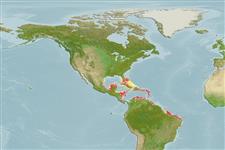Common names from other countries
Classification / Names / Names
ماع يماسا | فدارتم | Catalog of Fishes (gen., sp.) | ITIS | CoL | WoRMS
Environment: milieu / climate zone / depth range / distribution range
يسانش موب
; روش بل; قمع تارييغت 2 - 15 m (Ref. 415). Tropical
Western Central Atlantic.
Length at first maturity / Size / Weight / نس
Maturity: Lm ? range ? - ? cm Max length : 0.2 cm OT يسنج صاوخ نودب / رن سنج; (Ref. 415)
Encrusting sponge, 0.1 - 0.2 cm thickness. Smooth, and slippery surface, with regularly dispersed oscula: 0.2 - 0.3 cm in diameter. A conspicuous star-shaped canal system surrounds each oscula (Ref. 415). Color: light to dark blue or violet. Leathery (Ref. 85482).
Maximum body thickness: 0.2 cm (Ref. 415). On dead coral in reef environments: 2 to 15 m deep (Ref. 415). Also found in mangroves (Ref. 86836). Favors coral undersides, overhangs, and crevices in shallow and deep reefs and hard bottoms (Ref. 85482).
Life cycle and mating behavior
غولب | لثم دیلوت | یزیر مخت | اه مخت | Fecundity | )ورال ( دازوت
Members of the class Demospongiae are hermaphroditic. Life cycle: The zygote develops into parenchymella larva (free-swimming) before settling down on a substrate where it grows into a young sponge.
یلصا ذخآم
عجارم | هدننك گنهامه | ناراكمه
Collin, R., M.C. Díaz, J. Norenburg, R.M. Rocha, J.A. Sánchez, M. Schulze, A. Schwartz and A. Valdés. 2005. (Ref. 415)
NCUI زمرق تسرهف رد تيعضو (Ref. 130435)
ستياس رظن زا تيعضو (Ref. 108899)
Not Evaluated
Not Evaluated
اه ناسنا یارب رطخ
Harmless
یناسنا هدافتسا
| FishSource |
اهرازبا
يتنرتنيا عبانم
Estimates based on models
Preferred temperature
(Ref.
115969): 26.4 - 28.2, mean 27.5 (based on 517 cells).
یريذپ بيسآ
Low vulnerability (10 of 100).
تميق هقبط
Unknown.
